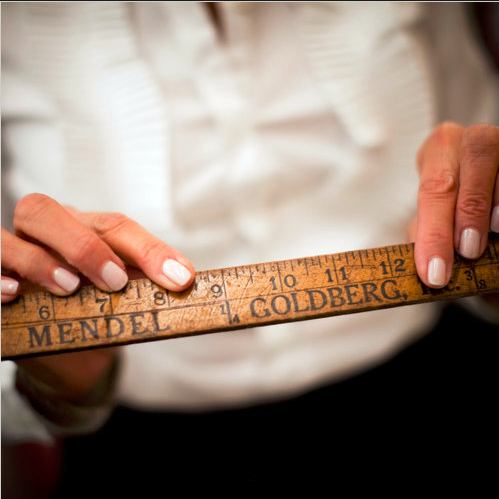NEIGHBORHOOD JOINT | LOWER EAST SIDE
A Turnover of Fabrics, Not Families
By ALEX VADUKULPublished in the New York Times: March 10, 2011

Whether the presence of a computer would disrupt the harmony of this preserved part of the old Lower East Side is a mystery. This small, last-of-its-kind store, near the corner of Hester and Allen Streets, has not left family hands since Mrs. Wildes’s great-grandfather, Mendel Goldberg, founded it when he arrived from Poland in 1890.
The store is a junglelike collection of fabric-filled shelves covering entire walls. There are woolens in every color, beaded laces that sell for as much as $1,600 a yard, and uncommon fabrics that the store’s four staff members can identify with a quick glance. In the basement, off-season and overstock fabrics are stored beside unsold fabrics from as far back as the 1950s.
It is one of the few stores in the city to specialize solely in fine imported European textiles. Mrs. Wildes, who is in her 50s, personally buys all fabrics on trips to Europe. She closely guards the identities of the suppliers she visits. “I have formed these relationships over many years,” she says of her contacts. “You cannot buy what I have anywhere else in the city.”
Her customers — costume designers from Broadway shows, rabbis from Brooklyn, uptown socialites — come to Mendel for exclusive fabrics that will become theirs alone.

On a recent afternoon, Mrs. Wildes helped one of her regular clients (an Upper East Side socialite) pick out fabrics for four suits and a cocktail dress. Mounting piles of French bouclé and bright Italian silk print surrounded them. They engaged in a dance for almost an hour: The client would excitedly point to fabrics that allured her; Mrs. Wildes would pull them, spread them across the client’s chest and then, usually, sternly say “no.” Rebuttals sometimes ensued at length but often ended with the client ceding to Mrs. Wildes’s judgment. “I have made very few mistakes here,” the client said. “Very few.”
“I like everything to be classy,” Mrs. Wildes said of the fabrics in her store, “but it has to have a kick. I buy what I like.”
The client nodded. “She buys what she likes.”
“I never buy for price.” “She never buys for price.”
Mrs. Wildes’s father, Samuel Goldberg, sat quietly on a nearby table piled high with tubes of fabric. Standing by him was Bruce Jackson, his right-hand man of 20 years. Mr. Jackson started running errands for Mr. Goldberg when he was a boy living in the neighborhood. Louis Ortega, who was helping Mrs. Wildes pull fabrics for the client, started around the same time. “We have fights here all the time,” Mr. Jackson said, “just like a family.”
Mr. Goldberg still runs the store with his daughter, who focuses on buying and selling. “Each Goldberg has done something slightly differently with the store,” he said. Mendel Goldberg primarily sold tailoring supplies, catering to the Lower East Side trade popular in his time. His son, Alexander Goldberg, began the store’s transition into selling fabric, but not of the luxury sort. Samuel Goldberg turned the store into a major supplier for department stores around the country. Mrs. Wildes was responsible for the store’s entrance into fine imported fabrics.
“When my father asked me to start running the store, I didn't know what to do,” she said. “I’m an Upper East Side girl, so I just did what I knew. I bought for the store like I bought for my closet.”
Featured Articles:
This Tight- Knit Jewish Family has Run Mendel Goldberg Fabrics Since 1890, by Jewish Telegraphic Agency
Where I Work: Mendel Goldberg Fabrics has been outfitting the Lower East Side for 130 years, by 6sqft
First-Ever Susan Alexandra Store - A Tribute to Lower East Side’s Jewish History, by Jerusalem Post
Featured Media
Family tradition is tightly woven at Mendel Goldberg Fabrics on the Lower East Side by CBS New York
The Neighborhood Joint by New York Times
New York Fabric Shopping, Part II The Vintage Traveler